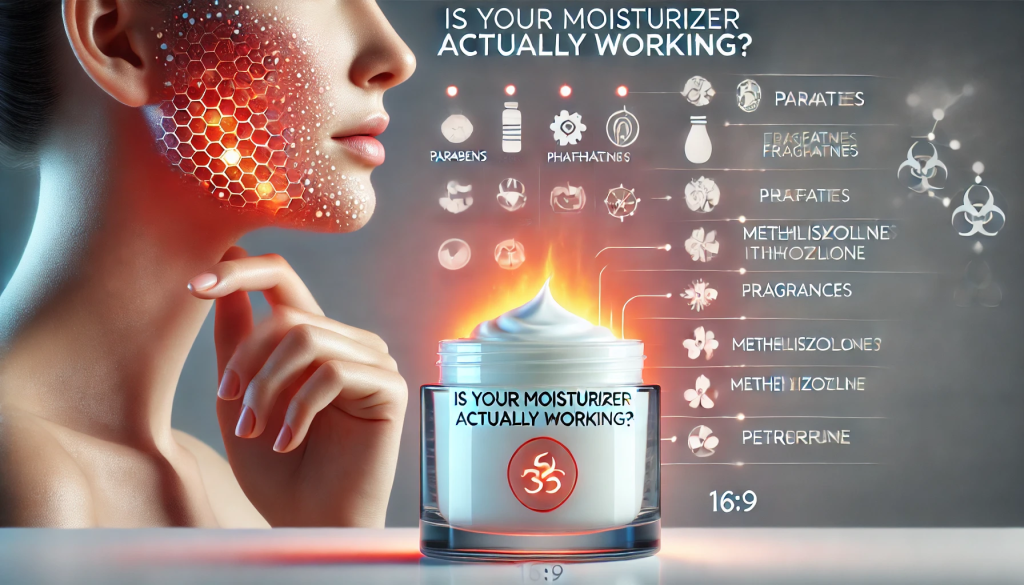Abstract: Moisturizers are essential in daily skincare routines, aiming to hydrate and protect the skin. However, certain ingredients within these products may inadvertently harm skin health. This paper examines five commonly used components—parabens, phthalates, methylisothiazolinone, fragrances, and petroleum-based products—highlighting their potential adverse effects. Through a comprehensive literature review sourced from Google Scholar, we explore how these substances can disrupt skin integrity, provoke allergic reactions, and contribute to broader health concerns. Understanding these hidden ingredients is crucial for consumers and professionals striving for optimal skin health.
Introduction

Moisturizers are formulated to maintain skin hydration, enhance barrier function, and provide a protective layer against environmental aggressors. Despite these benefits, certain ingredients may compromise skin health. This paper delves into five such components, elucidating their mechanisms and impacts based on current scientific evidence.
1. Parabens
1.1 Overview
Parabens are a group of synthetic compounds widely used as preservatives in cosmetic products to prevent microbial growth, thereby extending shelf life. Common variants include methylparaben, ethylparaben, propylparaben, and butylparaben.
1.2 Health Implications
Parabens possess weak estrogenic activity, meaning they can mimic estrogen in the body, potentially disrupting endocrine functions. A study by Darbre and Harvey (2008) detected parabens in human breast tumors, raising concerns about their role in breast cancer development. Although the study did not establish causation, it highlighted the ability of parabens to penetrate the skin and remain intact within tissue.
Further research by Boberg et al. (2010) demonstrated that prenatal exposure to butylparaben adversely affected reproductive development in male rats, suggesting potential risks to human reproductive health.
1.3 Regulatory Stance
In response to these findings, regulatory bodies have re-evaluated the safety of parabens. The European Commission’s Scientific Committee on Consumer Safety (SCCS) concluded that while methylparaben and ethylparaben are safe at certain concentrations, the use of longer-chain parabens like butylparaben and propylparaben should be limited due to insufficient safety data (SCCS, 2010).
2. Phthalates
2.1 Overview
Phthalates are a class of chemicals used as plasticizers in various consumer products, including moisturizers, to enhance flexibility and texture. They are often present in products containing fragrances, as they help stabilize scent compounds.
2.2 Health Implications
Phthalates are known endocrine disruptors. Research indicates that exposure to certain phthalates can lead to reproductive abnormalities and developmental issues. Swan et al. (2005) found an association between prenatal phthalate exposure and reduced anogenital distance in male infants, a marker of feminization.
Additionally, a study by Braun et al. (2013) linked prenatal phthalate exposure to behavioral problems in children, suggesting neurodevelopmental effects.
2.3 Regulatory Stance
Due to these concerns, the European Union has banned several phthalates from use in cosmetics. The United States has also restricted the use of specific phthalates in children’s products, reflecting growing apprehension about their safety.
3. Methylisothiazolinone (MI)
3.1 Overview
Methylisothiazolinone is a powerful biocide and preservative used in various personal care products to prevent bacterial and fungal growth.
3.2 Health Implications
MI has been identified as a potent sensitizer, leading to allergic contact dermatitis. A significant increase in MI-related contact allergies has been documented, prompting concerns among dermatologists. A study by Lundov et al. (2011) reported a rise in MI allergy cases following its increased use in cosmetics.
3.3 Regulatory Stance
In response to the surge in allergic reactions, the European Commission prohibited the use of MI in leave-on cosmetic products in 2016 and restricted its concentration in rinse-off products (European Commission, 2016).
4. Fragrances
4.1 Overview
Fragrances are added to moisturizers to provide a pleasant scent. They can be composed of numerous natural or synthetic aromatic compounds.
4.2 Health Implications
Fragrance ingredients are among the leading causes of allergic contact dermatitis. A study by Johansen (2003) highlighted fragrances as significant allergens, causing reactions ranging from mild irritation to severe dermatitis.
Moreover, some fragrance compounds, such as musk xylene, have been identified as potential endocrine disruptors and bioaccumulative substances, raising environmental and health concerns (Rimkus, 2004).
4.3 Regulatory Stance
Regulations require the disclosure of 26 specific fragrance allergens on product labels in the European Union. However, the term “fragrance” or “parfum” on labels can still mask numerous undisclosed chemicals, making it challenging for consumers to identify potential allergens.
5. Petroleum-Based Products
5.1 Overview
Petroleum-based ingredients, such as mineral oil and petrolatum (petroleum jelly), are commonly used in moisturizers for their occlusive properties, forming a barrier to prevent water loss.
5.2 Health Implications
While generally considered safe, concerns have been raised about the purity of petroleum-based products. Impurities like polycyclic aromatic hydrocarbons (PAHs) present in unrefined petroleum products are known carcinogens. A study by Fuh and Hu (1995) detected PAHs in various mineral oil products, highlighting potential contamination risks.
Additionally, over-reliance on occlusive agents like petrolatum can lead to a condition known as “skin dependency,” where the skin reduces its natural moisturizing factor production, potentially leading to dryness upon cessation (Loden, 2003).
5.3 Regulatory Stance
Regulatory agencies require that petroleum-based ingredients used in cosmetics be highly refined and free from harmful impurities. The U.S. Food and Drug Administration (FDA) lists petrolatum as a safe skin protectant, provided it meets specified purity standards.
Conclusion
While moisturizers play a pivotal role in maintaining skin health, the presence of certain ingredients can undermine their benefits. Parabens, phthalates, methylisothiazolinone, fragrances, and petroleum-based products have been associated with various adverse effects, from allergic reactions to endocrine disruption. Consumers should be vigilant, reading ingredient labels and opting for products with safer alternatives. Further research and stricter regulations are essential to ensure that moisturizers contribute positively to skin health without unintended consequences.
References
Boberg, J., Taxvig, C., Christiansen, S., & Hass, U. (2010). Possible endocrine disrupting effects of parabens and their metabolites. Reproductive Toxicology, 30(2), 301-312.
Braun, J. M., Sathyanarayana, S., Hauser, R. (2013). Phthalate exposure and children’s health. Current Opinion in Pediatrics, 25(2), 247-254.
Darbre, P. D., & Harvey, P. W. (2008). Paraben esters: review of recent studies of endocrine toxicity, absorption, esterase and human exposure, and discussion of potential human health risks. Journal of Applied Toxicology, 28(5), 561-578
